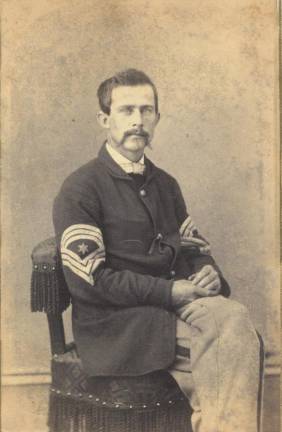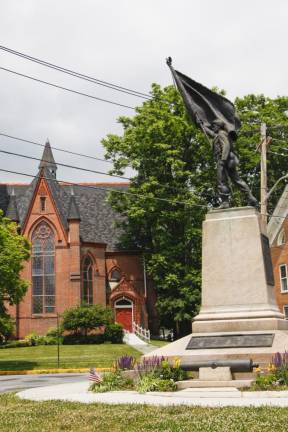Chester's Citizens in the Civil War: The Bugler
Chester. Moses P. Ross, a member of the Orange Blossoms Regiment, was one of the Union Army's "brightest, noblest members, a man above reproach."


In the office of Chester Town Historian Clifton Patrick is a glass display case laden with local artifacts, including awards, padlocks, and booklets. On the top shelf is an attention-grabbing bugle, tied with a faded red, white, and blue ribbon and dating back to the Civil War. Its original owner was Moses P. Ross, who served Company A of the distinguished 124th New York Volunteer Infantry Regiment, better known as the Orange Blossoms. This regiment, made famous by Stephen Crane’s novel "The Red Badge of Courage," saw extensive combat, taking part in famous Civil War battles such as Chancellorsville, Gettysburg, and the final battle of Appomattox Courthouse.
Ross was eager to serve his nation in its time of need. He enlisted in August 1862 in Goshen. On Sept. 6, the Orange Blossoms would muster at the Erie Railway Station, which now serves as the Goshen police station. Ross fought in all of the regiment’s great struggles, surviving American’s deadliest conflict due to limited medical capabilities. He was originally Chief Bugler of the regiment. After distinguishing himself through dedication and aptitude, Ross was transferred to non-commissioned staff.
A treasured gift
Since Roman times, buglers relayed instructions from officers to their troops, from marching orders to attacks to wake-up calls. Ross was an integral part of ceremonies, including parades and inspections by commanding officers. The company commander, Captain Charles H. Weygant, presented Ross with a bugle, a treasured gift engraved with his name, in acknowledgment of his exceptional service.
At the second annual reunion of the Orange Blossoms held on Sept. 17, 1875, between 2,000 to 4,000 people attended, though only about 225 of them were veterans of the regiment. All of its commanders were present. Ross played a major role in the reunion, playing "Taps" over the graves of fallen comrades.
Ross was involved with veterans organizations for the rest of his life. He helped found and became commander of Anderson Williams Post No. 394. He was a member of the Commanders and Quartermasters Association, Knights of Pythias, and many other well-known groups of the era. He was widely recognized for devoting the best part of his life to charity, and for his mercy to poor veterans and their families. He was known as a friend to all.
Grand tribute to a noble man
On April 28, 1903, Ross died at the State Arsenal, located in New York City's Central Park. His funeral was held at the Arsenal two days later, attended by more than 600 friends and mourners. Several veterans groups took part in the ceremony. Countless floral tributes were presented. Local newspapers noted their number and beauty.
Following the ceremony, Ross laid in state with an honor guard as mourners paid their last respects. The next morning, his body, escorted by the commanders of local veteran groups, was transported by ferry back to Chester. He was accompanied by a wagon filled with even more floral tributes. The Orange County News said the Grand Army of the Union lost “one of its brightest, noblest members, a man above reproach."
It's been more than 115 years since Ross's death, but his name and legacy live on, in no small part thanks to his bugle being in the possession of the Chester Historical Society. He would not live to see the 1907 dedication of “The Standard Bearer,” a statue in Goshen commissioned in honor of the Orange Blossoms by a fellow member, U.S. Rep. Thomas W. Bradley. But his legacy is also represented by the statue.
The last Orange Blossom, Theodore W. Penny, died in 1944 at the remarkable age of 99. Orange County still takes great pride in the regiment's service and sacrifice to keep our nation whole. Like many other notable citizens of Chester, Ross rests in the Chester Cemetery, his grave marked by a humble stone, a testament to a life well-lived.
A special thank you to Clifton Patrick and the Chester Historical Society, whose extensive assistance and resources, made this article possible.
Editor's note: The original version of his article referred to the bugle as silver. That was only a reference to its color. It is a regular metal bugle.
His funeral, held at the State Arsenal in New York City's Central Park, attended by more than 600 friends and mourners and filled with countless floral tributes.